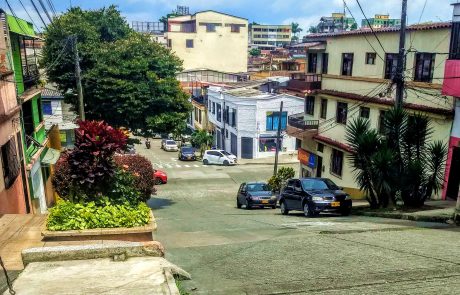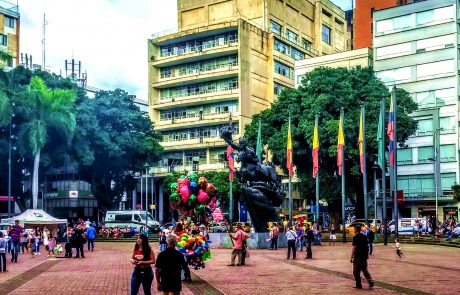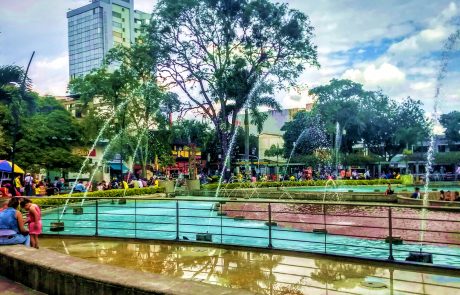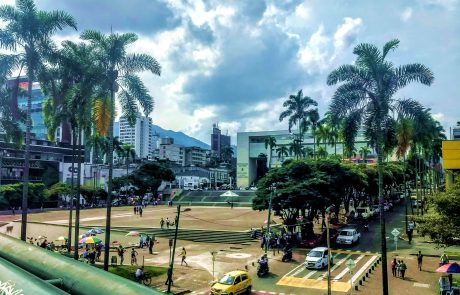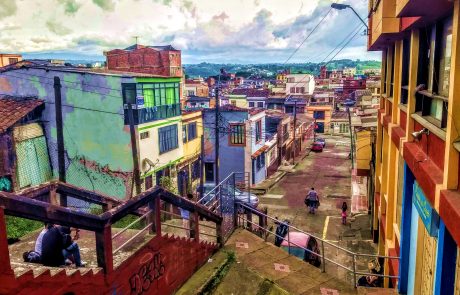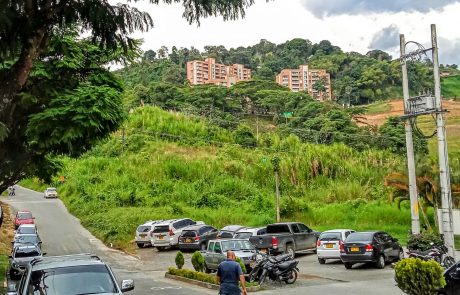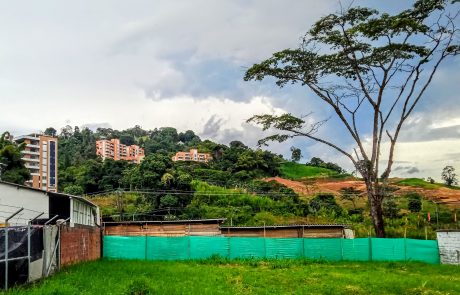June 2019
 Pereira, the capital of Colombia’s Coffee Triangle, doesn’t hit rockstar level in any tourist information I’ve come across. It gets very good reviews from a small subset of the expat retirement crowd because of its temperate climate, wide range of good services and lower cost of living than Medellin, which is both the retirement and the tourist hotspot of the country. The impressions to be garnered from the web are, however, spotty at best and give a poor impression of the city I’ve been cruising around in for the past two weeks. My purpose in this post is to give a different and more detailed profile of the city from the tourist perspective, the only one available to me after so short a time on the ground here. I came across a guide native to the city with whom I made an arrangement for hourly services. I’ve seen things, gone places and deepened my understanding in ways that would have been impossible without his help. So kudos to Andrés for helping me sort out both the city and myself in the city, something that would have been much more difficult without his assistance.
Pereira, the capital of Colombia’s Coffee Triangle, doesn’t hit rockstar level in any tourist information I’ve come across. It gets very good reviews from a small subset of the expat retirement crowd because of its temperate climate, wide range of good services and lower cost of living than Medellin, which is both the retirement and the tourist hotspot of the country. The impressions to be garnered from the web are, however, spotty at best and give a poor impression of the city I’ve been cruising around in for the past two weeks. My purpose in this post is to give a different and more detailed profile of the city from the tourist perspective, the only one available to me after so short a time on the ground here. I came across a guide native to the city with whom I made an arrangement for hourly services. I’ve seen things, gone places and deepened my understanding in ways that would have been impossible without his help. So kudos to Andrés for helping me sort out both the city and myself in the city, something that would have been much more difficult without his assistance.
I realized yesterday as I was walking around the city center that I’ve already formed impressions and opinions about the place. At this point, still early in the game, it’s likely those impressions will change as I continue my two-month stay here. That said, I want to give a rundown of the awarenesses that come from experiential evidence and afford easy articulation. So here we go, by category, with some pics to give a visual impression of the place.
Setting and Topography
I’ve never been in a place that has so many ups and downs. Seattle near the waterfront has streets that lead up from the water’s edge with quite respectable inclines, but Pereira is built on what seems a series of steep ridges separated by narrow valleys. Everywhere you look you see steep inclines. There’s no way to bulldoze such hills into submission for a spot of flat land, you just have to go with the topography to hand. Here are some pics to make the point:
I’m not a professional photographer (not that you needed to be reminded LOL) and I find it challenging to capture the steepness of a city street in a photo. Trust me, the inclines you come across in the city will make you wonder how on earth civil engineers came upon the idea of putting streets where they are. It makes for an interesting cityscape, though, since from any standpoint you’re looking at multiple levels, usually with a view into the distance. In that regard the ups and downs have everything to recommend them. They make Pereira a city of continually shifting vistas and perspectives, something I find quite attractive.
If you’re the type to do a lot of walking you can dispense with your gym membership. The ups and downs you meet as an adventurous pedestrian will find you scaling sidewalks steep enough to have you on the balls of your feet to negotiate the ascent. The first few days brought some complaint from my leg muscles because they’d been idle on flat ground for some months, but after a week out on the streets I find myself sailing up the sidewalks in the hilly areas with as much ease as the natives. I welcome the exercise. It’s about time I got off my duff and finally developed those buns of steel I’ve always wanted. 🙂
Safety and Security Issues
It’s no secret that Colombia has a checkered past. Violence was a large part of that past and the signs of it still show in people’s attitudes and habits of mind. Colombia is also a relatively poor country by American or European standards. To these things must be added the impact on Colombia of the situation in Venezuela. Colombia has shown great compassion in allowing millions of refugees into the country, but it’s hard enough for Colombians to find jobs without millions of destitute Venezuelans thrown into the mix. All of this makes for a set of conditions I’ve not dealt with before. Once again the guide I hired has been an invaluable source of information from someone who lives here and knows those conditions very well. I’ve learned things I’ve not found published anywhere on the Internet.
My own experience has been quite benign but I know that’s because I’m careful about what I do. Theft is a big problem here and as a white expat tourist I’m a prime target, so I take serious precautions. I keep my money stowed in a safety shoulder bag that never leaves my side. I take a copy of my passport info page and the page with the Colombian immigration stamp when I go out and leave the Real McCoy in a handy portable safe in my apartment (bought from Amazon and brought with me from the States). I don’t wander about at night unless it’s within easy walking distance of my place. I wouldn’t dream of walking around by myself in the city center at night. I’d stick out like a sore thumb and there are enough unsavory characters floating about during the daytime to make the nighttime seem decidedly unattractive for a solo stroll in the downtown area.
There’s a Colombian phrase that sums the matter up nicely: no dar papaya (= not giving papaya). It means don’t give anybody the opportunity to do something dodgy — the assumption being that if given that opportunity they’re likely to take it. It means don’t flash your cash, don’t sport two Rolex watches when you’re wearing short sleeves, don’t wander into a poor neighborhood in the dead of night dressed in a Hawaiian shirt while speaking English. As a newbie it’s hard to know exactly where the line is that keeps you on this side of “giving papaya,” but the last thing I want to do is run around in a state of paranoid hyperanxiety suspiciously eyeing everyone who crosses my path. Take all the precautions you can think of, then relax your attention to a state of reasonable watchfulness, that’s my tack. It’s worked like a charm so far.
There are beggars who bug you in the city center and a few homeless people sleeping on the streets and people hawking gum and candies and the like, but things are no worse here than they were in the Philippines. As an expat tourist you can inhabit a different zone than the natives. You can insulate yourself from the city nitty gritty if you want by staying in nice places. In the daytime I feel perfectly safe walking through some of the poorer neighborhoods as I move from my place to the city center. I certainly wouldn’t make the same journey on foot at night. I also speak fluent Spanish so I can give as good as I get when it comes to dealing with pushy touts or beggars with a long sob story. That helps a lot here in Pereira where next to nobody speaks English.
All that said it’s important to give full credit to Colombia for radically changing its national situation in a relatively short time. I read in one of the blogs I came across that as a tourist the last thing you should talk about is the past — the drug cartels, Pablo Escobar, the guerillas of the FARC groups, etc. etc. Colombians have worked hard to move on and leave that horrid history behind them. I think they’re doing a great job of it. I don’t feel unsafe in Pereira as long as I stick to reasonable behavior that accommodates both the conditions of the city and my own status as an expat tourist. I don’t think I’d feel as safe in New York City, to be perfectly honest.
Transportation and Traffic (and Noise)
When you reach a certain age you gain the right to speak your mind. You also have a free pass to avoid the rigors and inconveniences of public transportation. I planned to have a car for the entire stay — it was my splash-out to make things as much like home as possible so I could enjoy the travel rather than spend all my time figuring out how to get from place to place, which can be a real pain in the patoot.
Well … just goes to show how little you find out until you get on the ground and see for yourself. I knew before I got here things were dodgy with parking, but I had no idea just how dodgy. Pereira is a city built for a bygone age. The streets are narrow, buildings have no parking space, it’s all designed for donkeys and carts hauling produce and bags of coffee around. So finding parking is not only yeoman’s work, it usually requires divine intervention. Fortunately I didn’t do the car rental thing right away, the few red flags I saw thrown up in the travel literature made me hesitate and OH BOY am I glad I did. The vacation rental apartment I have is on one of the busiest streets in the city. There’s no parking for blocks and blocks around. The landlord suggested I chat up the parking attendant at a nearby bank — you know, slip him some cash and he’ll fix you up. That sort of thing. The day I moved in I walked over to the bank and found five parking places with five cars in them and motorbikes crammed in on each side of every car. I needed no more than a second to determine that I would rather slit my wrists than deal with that mess. So my reality-adjusted plan is to rent a car for the day I’m leaving town and return it to the agency on the day I get back. Voila! No parking problem! The element of spontaneity I had hoped to engage is, of course, squarely out the window, but it beats having to deal with the parking issue.
Driving in Pereira is kind of like one of the Fast and Furious movies. The road system looks like it was designed by Salvador Dali. People drive like they’re on their way to the hospital with a woman whose contractions are FAR too close together for comfort. It’s not for the faint-hearted. To this pandemonium is added the fact that nearly all streets in the city are one way. If you’re native you have a clear sense of how the pattern works. If you’re a newbie from out of town you’re on your own, babes. And the devil takes the hindmost (which might mean your rear bumper).
A native Pereiran would probably counter, “well, it works, that’s the main thing.” So does doing the dishes with Tide if you’re in a pinch while camping. But it’s not how life should be on a daily basis. There’s a reason God made dish detergent and two-way streets. So my opinion about Pereira’s traffic is: things could be done better with a little planning — wash my American mouth out with soap (Ivory is OK but not Tide, pretty please!).
Another important point for those coming from the States is the general decibel level. Traffic is not regulated so all kinds of vehicles go through the streets at all hours of the day and night. If you’ve just finished that chapter of the novel you’re reading and are ready to drift off, don’t be surprised if a fully loaded truck goes by your building at 11:30PM and uses its airbrakes to stop at the light one block away. Yes, Bridget, I speak from experience. I’m still alive to tell the tale but check back with me at the end of my two months’ stay and see how things are going. There may be one or more casualties before we reach the end of the story.
There’s no changing any of this, of course — there’s as little chance of that as there is a chance of redeeming it in any way. It’s up to you as the tourist to do as the locals do. It’s all Business As Usual to them. Sometimes the work of adaptation can take the ginger out of you, but there’s only one option: rearrange your circumstances if you can’t hack the current ones. If you’re in an Airbnb rental that’s easier said than done. So dial up that adjustment knob and get used to things. Better luck next time if you end up on a thoroughfare that makes sitting on your balcony feel like standing in the middle of the Jersey Turnpike during rush hour.
If you’re not the driving type, you’ll be pleased to know that taxis are good in Pereira. They use meters and there’s no haggling over how much it costs to get from Point A to Point B. During rush hour you may well find yourself waiting a good while before you can find an empty one to flag down, but there’s also a taxi app called Tappsi Easy that will help out (but only if you speak Spanish). I’ve used taxis since my arrival here and have never had a problem. It’s a relief to leave the driving to somebody else in Pereira’s traffic, so give yourself a break and let the taximan do it. Trips across town are a couple bucks at most so it’s cheap and cheerful into the bargain.
Householding and Grocery Shopping
If you go the Airbnb route as I’ve done and find an apartment rather than a hotel as your accommodation you’ll end up being domestic since that’s part of the gig. Shopping is good in Pereira, it’s the commercial hub of the Coffee Triangle. There are plenty of malls and shops all over the place. Some of them will follow a pattern Americans are familiar with, like Dollar City and Exito (one of the main supermarket chains), others follow the European model of small shops handling only one thing. Prices are good by American standards, even in the chain supermarkets.
The great delight for me as an apartment dweller responsible for getting my own grub together is what’s called a “galeria” here, essentially a public market for fruits and vegetables. As one might expect from a country in the top five biodiverse nations in the world, fruits and vegetables are abundant. To American eyes they look like technicolor versions of the standard items and they’re incredibly cheap into the bargain. One of my major gripes with the Philippines was the poor selection of vegetables in a country that can grow stuff 365 days a year. My produce dreams have come true here in Colombia. The first time I went to the public market I nearly started to hyperventilate. Everything a cook could ask for and then some, at prices you’ll never see in a million years in Safeway. Avocados the size of small melons, mangos of several different sizes and flavors, huge heads of snow-white cauliflower for a pittance. Yeehaw. The first meal I made at home was a huge chef’s salad with a huge fruit salad for dessert. I can get beets, carrots, green beans, celery, all the regulars in addition to yucca, plantains and a few others I’ve yet to identify. Fruits come in an enormous variety since they grow in different ecosystems, some tropical, some at higher elevations where cool-weather crops grow well. In addition to bananas, strawberries, apples and the like you’ll find things that look like they were designed as props for a horror film but taste divine. I’ll be some weeks trying it all and figuring out how to use it in the kitchen.
Restaurant fare, however, is quite another matter. The other day the guide took me to one of his favorite places featuring dishes from Tolima Department, to the south of Risaralda Department of which Pereira is the capital. “Authentic Tolimense Lechona” — roast suckling pig, Tolima’s claim to fame. I ordered the most classic thing on the menu and what came out of the kitchen looked like the dog’s dinner with a taste about as exciting as a visit to the dentist. There was plenty of it, that much I’ll give them, but I found nothing else to recommend either what I had or what the guide chose, a Tolimense tamale — a huge thing stuffed with what looked very much like what I had on my own plate.
Two days later we went to a restaurant featuring typical dishes from the Eastern Plains region (Llanos Orientales), which is Colombia’s answer to Texas barbecue or what you’d expect from an Argentinian churrasquería. The barbecue was great — not as inventive as the Texan version, to be sure, and there were no special barbeque sauces whose secrets people would kill to protect, but it was quite tasty. A visit to a Mexican restaurant the following day led to bitterly dashed hopes. No Mexican would have recognized the burrito I got, despite it being wrapped in a flour tortilla. The salsas provided were pathetic — a bit of salty guacamole that resembled the real deal only in color, something that looked and tasted like ketchup with a bit of cayenne thrown in, and pico de gallo that bore absolutely no resemblance to the Real McCoy. Dagnabbit. I knew before I got here that Colombian food was gonna bore my socks off — and sure enough, BINGO! I had hoped to take refuge at a good Mexican restaurant once in a while just to wake my taste buds from their Sleeping Beauty slumber. No such luck. Maleficent’s thorn hedge has encircled the entire city and put everybody’s tastebuds to sleep, apparently. There are hot peppers available in the public market, however, so you can bring in Prince Charming for that crucial kiss yourself if you’re handy in the kitchen. Otherwise, prepare to be underwhelmed and have your tastebuds in a continual doze. There’s a reason things are like that — Colombia was, after all, colonized by Spain. If you do a bit of homework about traditional Spanish cuisine, it all becomes crystal clear. Starts with B, rhymes with “warring.” 🙂
Healthcare
You’re in luck as tourist in Pereira if you need medical care. During my recent visit to the USA I was reminded just how thorny of access and expensive health care is in the USA. I didn’t even bother with it, knowing that in a few weeks I could go to a clinic in Pereira, get an appointment the next day rather than three months down the road, and pay a fraction of what I’d be charged in the States.
Recently I went to a very fancy ophthalmologic clinic in the swanky part of town. Intake took 10 minutes and it only took 15 minutes until I was in the hands of the doctor, who had at his disposal equipment that looked brand new and as fancy as anything I could hope to find in the States. The business was conducted efficiently and with consummate attention to client comfort. The cost? $60. It’s astronomical for Colombian standards but for the likes of us gringos used to getting fleeced for two or three times that for a 15-minute office visit, it’s a bargain that can’t be beat.
There’s just one hitch. The clinic website astonished me because it was almost entirely in English. I wondered if the staff, upon seeing my American passport at intake, would flip into flawless English. Not a bit of it, it was Spanish 100%. My Spanish is quite good and fortunately was up to the job of answering a ton of medical questions. If you don’t speak Spanish, however, you’re in a bind because people here don’t speak English. That’s not a hasty generalization, it’s a statement of lived experience. So if you need to seek out healthcare and you don’t speak Spanish, you’ll need to take along somebody who does. Such people can be hired if need be through a tourist guide operation. Linguistic difficulties aside, you can rest assured that you’ll have fast and easy access to whatever healthcare services you want, at a cost far easier on your wallet than anything you can get in the States. There’s good reason Colombia is fast becoming one of the go-to places for medical tourism. Both the quality of care and the cost of Colombia’s healthcare available to tourists put the United States to shame and show up the American healthcare system for the omnishambles it is.
Money Stuff
Some countries make it easy to open a bank account. Thailand, for example. All you need is your passport and something to deposit and in 20 minutes they’ll have you fixed up with a passbook and a login to the online banking platform. NOT so in Colombia. You can’t open a bank account without a national ID card (cedula), which you can only get as a resident, not as a tourist. So you need a strategy in place to get yourself supplied with bucks while you hang out in Biodiversity Paradise.
My strategy works fairly well so I’ll pass it on. If you have accounts with the right banks in the USA you can withdraw money using an ATM card in Colombia at the bank rate without any foreign transaction fees. Capital One 360 is my go-to bank for that. The debit card I have for my checking account gets me the rate set by Capital One with no transaction fee on their side. There may be a transaction fee from the Colombian bank you use, but hey, that’s the cost of doing business.
The biggest bank in Colombia, BanColombia, is a Cirrus member, so if your US bank is a Cirrus member you’re in good shape. Capital One is not a Cirrus member, so my debit card won’t work at BanColombia ATMs. When I tried it I got a message (in Spanish, of course) about my card not being part of the Cirrus family. Well boo-hoo. So off I went in search of another bank who would treat tourists a bit more generously. I’ve found two thus far — BBVA (“bay bay uvay ah” in Spanish) and Davivienda. I recommend Davivienda because it offers the possibility to withdraw large sums, a discovery that nearly had me dancing for joy in the ATM booth. I stopped myself before creating a scene, don’t worry. The last thing anybody in Pereira needs to see is an old white guy doing the Happy Dance. 🙂 See? My momma raised me right.
Western Union is a good option for sending money to yourself while you’re abroad, but only if you can get dollars paid out at the local agency where you are. The conversion rate WU offers via its app or online platform is horrible, so I never ever send in a foreign currency, only in dollars, and then do the conversion locally when the rate is advantageous. It’s easy to sign up for a Western Union account and download the mobile app for your phone, which is what you’ll need to do a self-send while abroad. I used the self-send technique regularly in the Philippines and it worked a treat. I’ve yet to try it in Colombia. Fingers crossed it’s as easy as it was in the Philippines.
Closing Thoughts
I chose Pereira over other places in Colombia because my research led me to the conclusion it was the hostess with the mostess. I was right. It’s not a place much sought out by expat tourists and I’ve yet to come across an expat retiree in my wanderings. I know a few are here, but they’re not obvious. On the street as I go about my business I’m always the only old white guy with a funny accent. Since I hate big cities it never even entered my mind to try out Medellin, and even if I did like big cities Bogota would have scared me off both for its size and because it’s not a particularly safe place. Faced with a choice between Cartagena, Bucaramanga or Pereira it was Pereira that won out because it offers everything a long-term tourist could want while being in a part of the country that has landscapes to die for. Cartagena is touristy, expensive and steamy hot. Bucaramanga is, I believe, a close second to Pereira with regard to quality of life but the landscape around it is reminiscent of central Spain. Which is to say: bleak. Rugged and dramatic, perhaps, but bleak. I want green and plenty of it, which is exactly what I get here in Pereira.
Overall, then, I’d give Pereira an 8 out of 10. If the traffic/parking/noise situation were better it could easily hit higher on the scale. I feel I’m enjoying Pereira in its Golden Age. Development is going on at a rapid pace and it looks to me like another five years will find the city gasping under its own weight. Traffic is already nearing critical mass. The spread of the city into the surrounding countryside is noticeable but not alarming, since there’s a whole lot of countryside still there. But it’s not a sustainable growth pattern because there’s no investment in existing infrastructure. You can pile on the suburbs within a radius of three miles and it all looks OK, but the suburbs are going to be in the city center to work or shop or entertain themselves, so it bodes exceeding ill for the future of the central district where all the action is.
That said, I still feel I chose well and found the best place for someone like me. Within a week of arrival and getting set up in my apartment I was oerfectly comfortable going about my business just like one of the locals. Pereira is easy to move around in and it’s not so large that it takes months to learn all the different areas — including those in which a white tourist face would better NOT be shown.
All in all, then, Pereira gets a big thumbs up from this particular tourist. It doesn’t have the Louvre or the Prado, true, but hey, you gotta live. Pereira is very good at making that daily job pleasant as well as easy.

